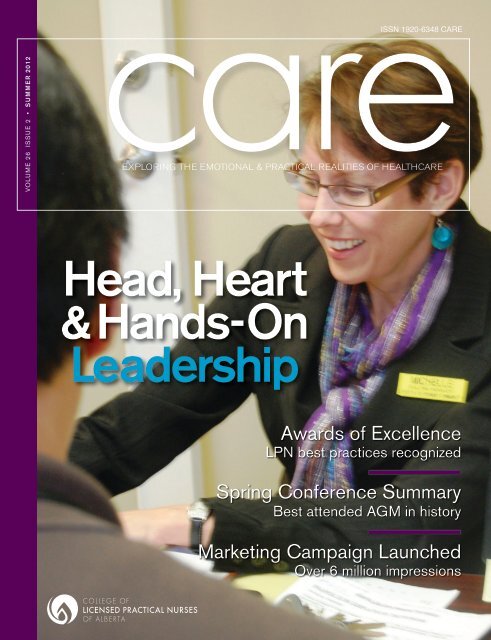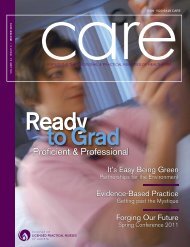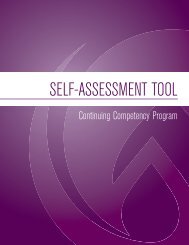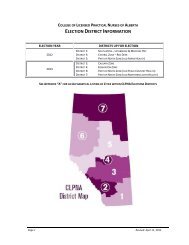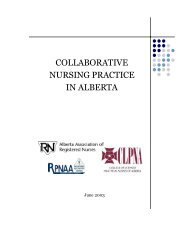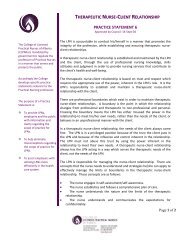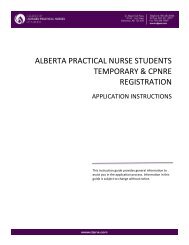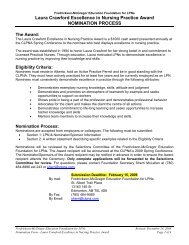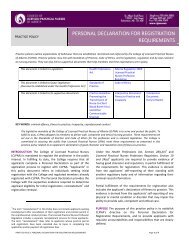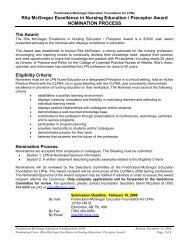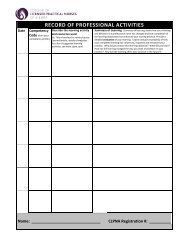Head, Heart & Hands-On Leadership - College of Licensed Practical ...
Head, Heart & Hands-On Leadership - College of Licensed Practical ...
Head, Heart & Hands-On Leadership - College of Licensed Practical ...
Create successful ePaper yourself
Turn your PDF publications into a flip-book with our unique Google optimized e-Paper software.
ISSN 1920-6348 CAREVOLUME 26 ISSUE 2 • SUMMER 2012<strong>Head</strong>, <strong>Heart</strong>& <strong>Hands</strong>-<strong>On</strong><strong>Leadership</strong>Awards <strong>of</strong> ExcellenceLPN best practices recognizedSpring Conference SummaryBest attended AGM in historyMarketing Campaign LaunchedOver 6 million impressions
from the collegeIT IS ALL ABOUT LEADERSHIPAnother Spring Conference is behind us, and as we approach the long awaitedsummer, there is an opportunity to focus on the theme <strong>of</strong> “Creating the LeaderWithin: You - Your Team - Your Work.”LPN’s and other regulated healthcare pr<strong>of</strong>essionals <strong>of</strong>ten work in less than optimalpractice settings. As we commented in the Spring 2012 CARE issue, our registrantscontinually face the implications <strong>of</strong> funding <strong>of</strong> the health system, serious providershortages, an aging workforce, heavy reliance upon part-time and casual staffing, lowmorale and productivity, and ongoing efforts to “streamline the health system.” Theseconsiderations must be balanced, from the front line to the executive suites, withcontinuing emphasis on the health system’s effectiveness, efficiency, the quality <strong>of</strong>health services, patient safety and access to the system.Take an opportunity to search the term “leadership” on the Internet, and you will find over 30,700,000 references, in 0.09seconds. Here are two favourites:“To lead people, walk beside them… As for the best leaders, the people do not notice their existence. The next best, thepeople honour and praise. The next, the people fear… When the best leader’s work is done, the people say “We did itourselves!” Lao - Tsu (a mythical Chinese philosopher, who lived 2,500 years ago.)”Fast forward to Isaac Newton, considered the greatest scientist <strong>of</strong> all time, who in the late 1600s said:“If I have seen further than others, it is because I was standing on the shoulder <strong>of</strong> giants.”Each <strong>of</strong> us hasthe potential as“leaders within”to make adifference increating our workenvironments…<strong>Leadership</strong> in today’s health care system is particularly challenging. It is <strong>of</strong>ten difficult for us to acknowledgeand embrace our “leader within.” We work in an environment where financial constraints, organizationalturmoil, physical and emotional demands, and overall uncertainty take a significant toll.Workplace hostility, in particular bullying and emotional abuse from colleagues, other practitioners, patients,clients, and even supervisors is <strong>of</strong>ten subtle, cumulative and may become overwhelming. We have choicesin how we face each day - do our best, become negative and cynical, contribute as minimally as possibleand “quit but stay,” or leave the system for greener pastures.Each <strong>of</strong> us has the potential as “leaders within” to make a difference in creating our work environments. Inthis issue <strong>of</strong> CARE, you will see abstracts <strong>of</strong> some keynote presentations from our May 2 to 4 conference.We encourage you to reflect upon the messages, and consider how you can implement them in your workand everyday life.The Tri-Pr<strong>of</strong>essional Conference - “Strengthening the Bond” included representatives from the physician, pharmacistand registered nurse communities, three weeks after our conference. The theme was improving patient-centered careby strengthening teamwork and collaboration. This topic was complementary to our conference’s focus on leadership.It was certainly appropriate, given the recent provincial commitment to collaborative care. There is an abundance <strong>of</strong>academic literature and first-hand experience which demonstrates that effective and efficient teams provide higherquality and safer care.In less than a month, the majority <strong>of</strong> opinion leaders in our health system have heard and reflected upon the message<strong>of</strong> how to build a positive work environment. We believe there is a considerable momentum building to create the bestpossible leadership and team culture in our health care system.If over 600 people between the two conferences heard almost identical messages, now is the time to take personal andpr<strong>of</strong>essional responsibility to demonstrate our “leadership within.” This will mean taking risks, going outside our comfortzones, having difficult conversations, and truly becoming engaged.The academic evidence supports leadership and collaboration. The provincial government’s mandate reinforces thisconcept. The growing respect for our pr<strong>of</strong>ession provides us with a unique window <strong>of</strong> opportunity. The time is now todemonstrate our leadership competencies, collectively as a pr<strong>of</strong>ession and individually in every setting where we practice.Hugh Pedersen, President and Linda Stanger, Executive Director4 care | VOLUME 26 ISSUE 2
care | SUMMER 2012 5
Advanced Education inOrthopaedics Certificatefor LPNsNorQuest’s Advanced Education in Orthopaedics certificatewill open doors for you and provide many opportunities.Learn about advanced orthopedic assessment, traumaand specialized procedures including casting.For more information, call 780-644-6366or email laura.milligan@norquest.caTo register, call 780-644-6000or toll-free 1-866-534-7218www.norquest.caJOIN AWINNING TEAMhelp shapehome care practicesour Calgary, Red Deer and Edmonton locationsare currently recruitingCommunity Care Supervisors - LPNFor more information or to apply please e-mail:hrhomehealth@cbi.ca or visit our website cbi.ca/homehealth6 care | VOLUME 26 ISSUE 2
8 care | VOLUME 26 ISSUE 2
<strong>Head</strong>, <strong>Heart</strong>and <strong>Hands</strong>-on<strong>Leadership</strong>BY SUE ROBINS“I and Building Manager for Lifestyles Options, an assisted living community locatedhave a firm belief that I got from my parents – whatever you want to do, you cando it. So far this hasn’t let me down,” says Michelle Carew, LPN, Director <strong>of</strong> Carein Leduc, just south <strong>of</strong> Edmonton. Michelle started <strong>of</strong>f as a night nurse ten years ago,and has been supported by Lifestyles Options senior management to embrace one <strong>of</strong>the highest leadership roles in the organization.“There are LPNs in management levels all through the organization. I supervise almost100 staff, oversee resident services with residents and families and I am in charge <strong>of</strong> thebuilding,” explains Michelle. Nurses are Team Lead Supervisors, manage Health CareAides (HCAs), coordinate physician visits, and collaborate with other health pr<strong>of</strong>essionals.Michelle is constantly moving, but always cheerful. She patiently sits down with the daughter <strong>of</strong> aresident to explain her dad’s medications. Then she’s up, down the hall, waving to residents, andcalling them by name. This is a high energy position, but Michelle is up to the challenge.“When I finished nursing school, I realized I can do anything!” Michelle says brightly. While she grewup on Vancouver Island and had a passion for the ocean and marine biology, she was drawn to nursingwhen she was living in Cold Lake.“The LPN course was being <strong>of</strong>fered in Lac La Biche, and I decided to try it out. The courses wereso interesting, and I got to try a smattering <strong>of</strong> nursing experiences in a small hospital. I rememberworking in the OR, and the physician saying to me – don’t stand in the corner – get over here and seewhat’s going on – and he explained everything to me. It was such an amazing experience.”The base <strong>of</strong> Michelle’s leadership comes from her family growing up. Her parents had a can-do, roll upyour sleeves attitude that rubbed <strong>of</strong>f on Michelle, and has paid <strong>of</strong>f in this position, where challengesarise constantly, and problem solving skills are an asset.>care | SUMMER 2012 9
Step 5. Learn to Break the RulesWhat do you really want for yourself in work and inlife? To truly embrace the leader within, you’ll needto look past barriers that get in the way. If you wantsomething badly enough, do whatever you need todo to make it happen. Ask the questions, have theconversation, make the phone call, do your research.If it’s important enough to you then any barrier issurmountable.With every effort that moves you toward your goals,you’ll add a richness and energy to your life that noamount <strong>of</strong> healthy food and sleep can match. Did Ijust say that? I think I did.There is a wonderful quote in a novel calledBenjamin’s Gift that speaks to knocking downbarriers that stand between you and your dreams.He was convinced that laws existed only to guide thedull and the foolish and that a wise man’s pleasureconsisted in carefully and creatively subverting them.- Michael GoldingStep 6. Focus on the PositiveIt’s easy to get nervous and feel negative when you’restepping in to the unknown and trying new things.But no one said leadership was easy. As you travelthe path <strong>of</strong> growth and change pay attention to allthe things you’re doing right. Focus on the positiveoutcomes <strong>of</strong> each day. Embrace gratitude at thesame time that you’re embracing leadership. Whenyou practice positivity there will be less room forthe negative sabotaging thoughts to enter your headspace.MacEwan’s Centre for Pr<strong>of</strong>essional NursingEducation <strong>of</strong>fers distance certificate programsto help you take your career to the next level.Wound ManagementPost-Basic Certificate –Get your post-diploma certificate bycompleting five courses specialized inmanaging complex wounds.www.MacEwan.ca/WoundPerioperative Nursing for LPNs –Complete this four-course certificate andacquire the skills you need to work in thechallenging and team-oriented environment<strong>of</strong> the operating room.www.MacEwan.ca/PeriopLPNThis is important, because it’s far easier to go downthe road <strong>of</strong> negativity than it is to stay positive -especially when you’re taking risks and stretchingyourself. You can do it! That negative voice in yourhead operates from a place <strong>of</strong> fear and that won’t getyou what you truly desire.So...What one great dream would you dare to dreamif you knew you could not fail? It’s there for you ifyou truly want it. Chart your course, turn yourself inthe direction <strong>of</strong> your dreams and take a step! nMichelle Cederberg is a speaker, author and life coach whois passionate about helping people live a fully-charged life.Her shoot-from-the-hip style is a testament to the energy shebrings to her work. Her speaking and coaching integratesrealism and compassion that will help you charge towarda truly inspired and healthy life. To learn more visit www.worklifeenergy.com where you can find out about one-ononecoaching with Michelle or learn how you can bring herto your organization to speak.www.worklifeenergy.comCentre for Pr<strong>of</strong>essional Nursing Educationwww.MacEwan.ca/RNcare | SUMMER 2012 15
Do it Well.Make it Fun.®By Ron Culberson, MSW, CSPLife is short. In a relative, big picture kind <strong>of</strong> way.So, we must make the most <strong>of</strong> the short time wehave in this world. Whether you’ve just begun yournursing career or you’ve been at it for decades,there is always time to change the way youapproach your work (and your life for that matter).Abraham Lincoln said, “It’s not about the days inyour life, but the life in your days.”Richness. Success. Responsibility. They’re all about makingthe most <strong>of</strong> your days no matter how many days you haveleft. That’s the foundational principle <strong>of</strong> “Do it Well. Makeit Fun.” Excellence plus fun equal a valuable and valuedexistence.I spent a decade in hospice care (as an employee, not apatient!). I began that work as a 25-year old social workerand eventually moved into a senior leadership position. Icould not have asked for a better job to begin my pr<strong>of</strong>essionalcareer. Hospice taught me to value life. Hospice taught methat time is limited. And hospice taught me that we don’twant to have regrets when we get to the end <strong>of</strong> our lives.Recently, I attended a funeral <strong>of</strong> a man in my church. Duringthe service, his son shared that he had once asked his fatherif he had any regrets in his life. His father said, “My life hasbeen so full, there was no room for regrets.”What a blessing it would be to have such a full life that therewas no room for regret.Do it Well, Make it Fun refers to the now rather than thelater. It begins with excellence but it’s also about joy, or enjoy-ment.It’s about recapturing a childhood sense <strong>of</strong> fun andwonder that many <strong>of</strong> us lost after entering into the bitter,cynical, depths <strong>of</strong> adulthood. We shouldn’t have listened tothose who admonished us to just grow up and act like anadult. Instead, we should have grown up and had fun.But how do we deal with the stress <strong>of</strong> adulthood?Years ago, I began using a formula to explain the effects <strong>of</strong>stress. It looks like this:Stressor + Interpretation = Effects <strong>of</strong> StressSurprisingly, stress is not inherently stressful. Instead, stressis created by our interpretation <strong>of</strong> the “stressor”- an event oran experience in our lives. If stress were inherently stressful,then the same things would cause stress for everyone.So, if I interpret something as stressful, it will create astress-full effect in me, and then I’ll have to figure out howto cope with it. If I don’t interpret it as stressful, then thereis no stress effect and no need to cope.We just need to choose rather than react to our kneeflexes(automatic knee-jerk reflexes that are ingrained so that werespond without thinking). I know. Easier said than done.That’s why I’m writing this article instead <strong>of</strong> demonstratingit to you in person. Because I have kneeflexes too. But theformula does work. And if we change our perspective andsee the humor, it works even better.<strong>On</strong>e <strong>of</strong> the most effective ways to change your perspective isto see the humor that’s all around you. <strong>On</strong>ce, I went to mydentist but there were no parking spots in front <strong>of</strong> his <strong>of</strong>ficeso I parked in front <strong>of</strong> the <strong>of</strong>fice next door. The sign on thatdoor said, “Dr. Joseph Smith, Eyes, Ears, Nose and Throat.Rear Entrance.” I’m not familiar with that procedure but itdoesn’t sound too appealing!That’s the kind <strong>of</strong> humor that’s all around us but we’re<strong>of</strong>ten so focused on what’s going on with us, we fail to seethe gift <strong>of</strong> humor that’s been given to us.16 care | VOLUME 26 ISSUE 2
<strong>On</strong>ce we manage the way we deal with stress, then we needto manage the work we do. Interestingly, everything we dois a process. And every process has steps. And every stephas the potential to be improved and the potential to bemore fun.For instance, if you remember the steps you were taughtwhen you first learned to drive a car, they went somethinglike this:1. Put your seat belt on.2. Check your mirrors.3. Put your foot on the brake.4. Put the key in the ignition.5. Turn the key.6. Push on the accelerator.7. Etc. Etc. Etc.Today, you do these things automatically and don’t realizethat you’re simply going through each step <strong>of</strong> the process.But if you want to ultimately do things well and make themfun, you must break down the processes in your life andwork into steps. And then analyze the steps for possiblechanges.When I was 30, I went to my family practice doctor for myannual physical. He wanted me to have a prostate exam. Iwas curled up on the exam table, in the “tuck” position,facing the wall when I noticed a Post It note stuck to thewall right where my head was. Written on the note, wasthis: “My view is worse than yours.”My doctor had done an excellent exam. But he had alsomade it fun for me - or at least made it more tolerable.That’s the philosophy <strong>of</strong> Do it Well, Make it Fun.Everything in life is a process. If you do every process wellwhile making it more fun, I truly believe you will add lifeto your days. n© 2012 Ron Culberson. This information may be copied andshared as long as the following information is included.Ron Culberson, MSW, CSP is a former hospice social worker,middle manager, and senior manager who helps mission drivenorganizations tap into the power <strong>of</strong> combining excellence withhumor. Ron is the author <strong>of</strong> Do it Well. Make it Fun., Is YourGlass Laugh Full?, and My Kneecap Seems Too Loose.Find out more by visiting www.RonCulberson.comwww.gss.orgWe Need <strong>Licensed</strong><strong>Practical</strong> Nurses!Full time, part time and casual positionsAre you a LPN looking for a position that <strong>of</strong>fers competitivewages, comprehensive benefits, a variety <strong>of</strong> shifts, and theopportunity to improve the quality <strong>of</strong> life for individualsand their families?The Good Samaritan Society is in constant need <strong>of</strong>skilled LPNs who can deliver quality resident care.As one <strong>of</strong> Western Canada’s largest voluntary, notfor-pr<strong>of</strong>it,caregiving providers, we believe that abalanced work life contributes to healthy and happyemployees, who in turn provide the best care to ourresidents, which is what matters to us the most.• Visit www.gss.org to view all our jobopportunities• Please submit all resumes to:careers@gss.orgThe Good Samaritan Society is an equal opportunity employer.We encourage applications from all qualified individuals registeredwith CLPNA who have current First Aid and CPR.06140-CPLNA CARE Mag ad_r1.indd 12/23/11 3:22 PMcare | SUMMER 2012 17
CREATING THE LEADER WITHIN2012 SPRING CONFERENCE RECAPThis year’s annual CLPNA Spring Conference broughtmore than 350 LPNs and other health care pr<strong>of</strong>essionalstogether to focus on the leadership required to positivelyimpact healthcare. Program highlights included theCLPNA’s Annual General Meeting, keynote and abstractpresentations, an evening Celebration and AwardsBanquet, a healthcare Tradeshow and Silent Auctionfundraiser. The Conference was held May 2-4, 2012, atthe Edmonton Marriott at River Cree Resort in Edmonton.Commencing the Conference was Alberta’s Minister <strong>of</strong>Health, the Honourable Fred Horne, bringing greetingsfrom the province. In his address to LPNs, he acknowledgedhow much he and his Ministry greatly “value your work”and the “broad scope <strong>of</strong> practice you <strong>of</strong>fer”. “You do thisbecause you have a true and sincere desire to care foryour fellow citizens,” he acknowledged. Horne received aspontaneous burst <strong>of</strong> applause when he stated emphaticallythat the current government had no intention to undertakeanother reorganization <strong>of</strong> the healthcare system.Focus on Nursing IssuesThe leadership challenge from all the keynote speakerscould be summed up by Kathleen Bartholomew, “(Let’s)change the culture <strong>of</strong> medicine.” In “Healing Nurse-to-NurseHostility”, Bartholomew described the serious personal andpr<strong>of</strong>essional consequences <strong>of</strong> a hostile work environment .“No one can think straight when they are upset,” she said.She then shared step-by-step communications methods touse in difficult conversations to get results.Michelle Cederberg and Ron Culberson encouragedblending excellence and fun to lead to better patient care.Abstract sessions included retirement planning, seniorsand mental health, and improving communication. Newthis year was poster presentations, an opportunity forindividual attendees with research, best practices or otherinfo to share with attendees. Along with learning sessions,the Conference Tradeshow has something for everyonefrom jobs to jewellery. Conference bags were filledwith information and gifts from the various sponsors andexhibitors.Arm Chair Discussion– Policy & Healthcare in AlbertaA unique opportunity to hear directly from Alberta HealthServices (AHS), Alberta Health and Wellness (AHW) andCLPNA came during the first ever Arm Chair Discussion -Policy & Healthcare in Alberta.Moderator Steven Lewis lobbed dozens <strong>of</strong> big-picture healthsystem questions at the participants. The theme was clear.From Alberta Health and Wellness’ perspective, “The onlyway to meet (healthcare) demand is collaborative practice,”stated Bernard Anderson, Acting Executive Director for theWorkforce Policy & Planning Branch. Senior Vice PresidentDeb Gordon <strong>of</strong> Alberta Health Services expanded thatfor successful collaborative practice to occur “you have toinvolve people in the change.” She expressed a desire forhealth leaders to reflect on this question: “Are we all doingthe things only we can uniquely do?” Is the system optimallyutilizing every health pr<strong>of</strong>essional? CLPNA’s ExecutiveDirector Linda Stanger described the incredible opportunitiesfor today’s LPNs; the provincial government’s promise <strong>of</strong>140 Family Care Clinics <strong>of</strong>fers the 800 LPNs graduatingeach year more chances for fulfilling employment. Time forthe Arm Chair Discussion was extended an additional halfhour to hear from attendees eagerly directing questions tothe panel.Annual General MeetingThe work <strong>of</strong> the CLPNA in 2011 and 2012 was sharedwith a greater-than-usual 200 attendees at the CLPNA’sAnnual General Meeting. In addition to the release <strong>of</strong> the2011 Annual Report, attendees watched CLPNA’s four newGlobalTV commercials and saw a sneak peek <strong>of</strong> a newshareable web video (“<strong>Practical</strong> Solution”) released May 7.Celebration & Awards DinnerThe annual Celebration and Awards Banquet honoured thepr<strong>of</strong>ession on the evening <strong>of</strong> May 3. LPNs received Awards<strong>of</strong> Excellence for nursing practice, preceptoring/education,and leadership.18 care | VOLUME 26 ISSUE 2
CLPNA2012 SPRINGCONFERENCEThe 2012 CLPNA Spring Conferencewishes to thank all conferencedelegates, speakers, partners,and sponsors for your involvementand support. Your contributionsand attendance helped make thisyea’s conference a memorable andsuccessful event for all involved.SPECIAL THANKS TO OURGENEROUS SPONSORS:PLATINUMAUPEBow Valley <strong>College</strong>NorQuest <strong>College</strong>GOLDNorthern Lakes <strong>College</strong>www.clpnaconference.comSILVERAlberta Health ServicesCovenant HealthLakeland <strong>College</strong>BRONZECarewestMacEwanThe PersonalThe Good Samaritan SocietySUPPORTERColumbia <strong>College</strong>Field LawLethbridge <strong>College</strong>Lloyd Sadd Insurance Brokers Ltd.IN KINDION Print SolutionsMr. Pin ManGraphic Overloadcare | SUMMER 2012 19
Winners <strong>of</strong> the 2012 Awards <strong>of</strong> Excellence were honoured at the CLPNA’sCelebration and Awards Dinner on May 3, 2012 in Edmonton. A special HonoraryMembership was also announced during the evening.Award recipients are selected by a committee <strong>of</strong> the Fredrickson-McGregor EducationFoundation for LPNs. The Foundation is a non-pr<strong>of</strong>it society supporting CLPNAmembers through education grants, bursaries and awards. Each LPN recipient receiveda commemorative crystal award and $1000.HONORARY MEMBERSHIPGloria BauerHonorary Membership is reserved for non-LPNs who have rendered distinguishedservice or valuable assistance to the <strong>College</strong> resulting in positive recognition forthe pr<strong>of</strong>ession. <strong>On</strong>e <strong>of</strong> those special people is Gloria Bauer, Chair <strong>of</strong> the CLPNA’sEducation Standards Advisory Committee (ESAC).Previously, Director <strong>of</strong> the Royal Alexandra Hospital School <strong>of</strong> Nursing and facultymember <strong>of</strong> the University <strong>of</strong> Alberta, School <strong>of</strong> Nursing, Gloria’s expertise in nursingeducation, has been invaluable to the CLPNA. Gloria joined CLPNA as Chair <strong>of</strong>ESAC in 1999, the year following our mandatory upgrading and the beginning <strong>of</strong>significant changes in practical nursing education.Under Gloria’s direction, in her first year, ESAC refined the tools developed forprogram approval and completed a comprehensive document to guide the committeeand the educators through the program approval process. Within one year, ESAChad reached a significant milestone and could say with confidence that all practicalnurse education in Alberta met these standards and were delivering a high quality <strong>of</strong>nursing education. To ensure graduates <strong>of</strong> the programs were meeting the needs <strong>of</strong>the employers, an Employer Survey Tool was also developed for the <strong>Practical</strong> Nurse(PN) Programs to collect consistent data on satisfaction with the graduates. At thistime, there were three basic practical nurse programs approved, producing less than300 hundred graduates per year.>20 care | VOLUME 26 ISSUE 2
The intervening years have been exciting and busy forESAC, as the number <strong>of</strong> programs increased from threeto seven basic programs in public institutions and one ina private institution. As well, there are multiple brokeredsites to ensure delivery <strong>of</strong> practical nursing educationin all areas <strong>of</strong> the province. In 2003, when LPNs wereproclaimed, under the Health Pr<strong>of</strong>essions Act, post basicprograms for the Operating Room, Advanced Orthopedicsand Renal Dialysis were added to the list <strong>of</strong> programs tobe reviewed. All <strong>of</strong> this greatly increased the volume <strong>of</strong>work for ESAC and Gloria, in particular. As the Chair<strong>of</strong> ESAC and the team leader, Gloria has participatedin every on-site review <strong>of</strong> PN education in the provinceand is responsible for writing all the reports. Delivery <strong>of</strong>the program has expanded from three to thirty sites andproduces about eight hundred graduates per year.During this time, Gloria also completed a review forAthabasca University (AU) to determine articulation<strong>of</strong> practical nurse education with their BaccalaureateNursing Program. This resulted in a bridging programwhere LPNs get a full year <strong>of</strong> credit toward a degree.which is to be implemented in each <strong>of</strong> those <strong>College</strong>scommencing later this year.Gloria’s role as ESAC Chair has been to ensure that thehigh standards for PN education are met. She is highlyvalued for her expertise in curriculum design and not eventhe smallest detail escapes her attention.Gloria is a supporter <strong>of</strong> research to provide an evidencebased approach to PN education. And with her progressiveattitude, the education standards are always monitoredand updated to ensure they are current, relevant andmaintain our reputation as a leader in practical nurseeducation in Canada.As a leader and a mentor, Gloria has been instrumentalin moving the <strong>Practical</strong> Nurse in Alberta from a technicalrole to pr<strong>of</strong>essional nurse, widely respected in all aspects<strong>of</strong> the delivery <strong>of</strong> health care in Alberta.Gloria will end her position as Chair <strong>of</strong> ESAC on December31, 2012. Congratulations Gloria and Thank you.Recently, Gloria worked with the northern <strong>College</strong>s indevelopment <strong>of</strong> a collaborative <strong>Practical</strong> Nurse curriculumPAT FREDRICKSON EXCELLENCEIN LEADERSHIP AWARDMelanie Joyce, LPNIn her position as Vice President <strong>of</strong> We Care Home Health Services (We CareCalgary), Melanie is responsible for leading an operation serving 1300 clients andemploying 350 people. Under her direct supervision are service delivery, clinicalpractices, quality management, human resources, education and risk management.Melanie spearheaded numerous successful initiatives over the years. Recent examplesinclude accreditation without condition from Accreditation Canada; a perfect scoreon the Government <strong>of</strong> Alberta Certificate <strong>of</strong> Recognition Audit; and the highestPerformance Audit score ever achieved by any <strong>of</strong> the 50 We Care <strong>of</strong>fices acrossCanada.In partnership with Alberta Health Services, Melanie was instrumental in developingclinical initiatives such as “Care Assignment in Designated Congregate Settings” andfacilitating the creation <strong>of</strong> the Service Provider Clinical Practices Working Group,resulting in a “best practices” collaboration to this day. Evidence <strong>of</strong> her pr<strong>of</strong>essionaland clinical commitment also includes being a member <strong>of</strong> the Continuing Care HealthServices Standards Compliance Monitoring Committee, a member <strong>of</strong> the CLPNA’sHearing Tribunal, a past member <strong>of</strong> the Board <strong>of</strong> Directors <strong>of</strong> the Alberta HomeCare and Support Association.care | SUMMER 2012 21
RITA MCGREGOR EXCELLENCE INNURSING EDUCATION AWARDWanda McIntosh, LPNWorking out <strong>of</strong> High River General Hospital, Wanda McIntosh is an exceptionalpreceptor for an acute care practicum. She creates a very special learningenvironment for students. She makes it possible for students to be independent,while guiding encouraging and gently supporting through the learning experience.Loved by all her colleagues and students because <strong>of</strong> her never-failing positiveattitude and good humour, she’s a nurse who always keeps a cool head and a heartburning with passion for her pr<strong>of</strong>ession.Wanda shows that she believes the future depends on her students. And shebelieves quality <strong>of</strong> care is the result <strong>of</strong> teamwork. So, Wanda encourages her ownstudents to participate in the ongoing communication between disciplines in orderto see the big picture. As one <strong>of</strong> her student’s states, “People like Wanda are thereflection <strong>of</strong> the very nature <strong>of</strong> the nursing pr<strong>of</strong>ession... I was very lucky to havemet Wanda in the very beginning <strong>of</strong> my nursing career. Now I am doing my bestto follow her example, and I can only hope that one day she will be proud <strong>of</strong> beingmy teacher.”LAURA CRAWFORD EXCELLENCE INNURSING PRACTICE AWARDErin Longhurst, LPNAvocation. Commitment. Exemplary nursing. These words are personified in ErinLonghurst. Erin works in Calgary at both Calgary Urban Project Society (CUPS)as a nurse, and at Academy <strong>of</strong> Learning as a Health Care Aide Instructor. Asa clinic or lab nurse, Erin has the excellence in judgment and nursing skills toperform accurate nursing assessment and interventions in high-pressure situationsfrom alcohol withdrawal seizures to hypoglycemia in diabetics. Every week, sheand a nurse practitioner run a diabetic and pre-diabetic group for high risk clientsdealing with the complications <strong>of</strong> diabetes including nutrition, blood glucosemonitoring, exercise techniques and blood pressure monitoring.Because CUPS is a clinic with limited staff, teamwork and team building is vitallyimportant. The LPNs works very closely with the RNs, Nurse Practitioners,physicians and various specialists. Erin is always a positive presence in the clinic,working confidently and assertively with all team members. Erin has a wealth<strong>of</strong> ideas for improvement in nursing care at the clinic, including programs andresources for clients. Erin is motivated to go above and beyond for client care anddoes so consistently.22 care | VOLUME 26 ISSUE 2
2012 AWARD NOMINEES& BURSARY RECIPIENTSThe CLPNA and Fredrickson-McGregorEducation Foundation for LPNs congratulatethis year’s Award nominees andBursary recipients.INTERPROFESSIONAL DEVELOPMENTAWARDStephanie Keys, RNStephanie Keys has been instrumental in building a high qualitypractice environment at The Carewest, Colonel Belcher facilityas Education Coordinator. Stephanie is an excellent educatorthat is not only very knowledgeable, but also extremely kindand patient. She educates healthcare staff, including RNs,LPNs, Health Care Aides, and administrative staff. Herduties involve all units, from Supportive Pathways, LifestyleChoices, Designated Assisted Living to Adult Day Support.She also takes part in the monthly orientation <strong>of</strong> all new hiresfor Carewest, which has 12 sites. Stephanie does all this whilefostering a collaborative practice environment.Stephanie makes learning fun while promoting lifelonglearning. By creating an educational environment where staffmembers feel relaxed and welcome, everyone feels part <strong>of</strong>the team. She includes everyone during discussions and helpscreate a cooperative and high functioning Interpr<strong>of</strong>essionalteam. Stephanie has not only high regard for the healthcarestaff as a whole but she is always promoting and articulatingLPNs as an asset and a vital part <strong>of</strong> the team.Pat Fredrickson Excellence in<strong>Leadership</strong> AwardWinner: Melanie JoyceNominees:Karin FrederiksenRose GushueKaren JamesMelanie JoyceKarin Kettner-SmithShanna LeeMarie MacDonaldShera McConnellCatherine PickenTammy TarkowskiJune TeboNancy UnterschultzRita McGregor Excellence inNursing Education AwardWinner: Wanda McIntoshNominees:Courtney BelangerErin BellPat JarvisWanda McIntoshAnn NoseworthyKaren OlshaskiEryn WinfieldLaura Crawford Excellence inNursing Practice AwardWinner: Erin LonghurstNominees:Elaine CaouetteApolonia CudiamatMarie DoyleJackie DrakeRegena JonesKathleen LapointeErin LonghurstMarie MacDonaldGaylene MullettDarlene NemetzJudith NordquistDoreen VanEatonInterpr<strong>of</strong>essional Development AwardWinner: Stephanie KeysDavid King Educational BursaryRecipients:Jody MisunisDorothy Wurst-Thurncare | SUMMER 2012 23
esearchTelenurse Helpline ResearchVast majority <strong>of</strong> people who contacted telenurse helpline followed their advice(March 26, 2012) - Seven out <strong>of</strong> eightpeople who sought advice from atelephone helpline staffed by nursesfollowed the self-care advice they received,ranging from providing treatment athome to calling an ambulance, accordingto a study in the April issue <strong>of</strong> the Journal<strong>of</strong> Clinical Nursing*.Two factors had a significant impact onthe decision to engage in self-care forthemselves or the person they were callingfor. Callers who were more satisfied withthe nurse interaction were nearly fourtimes more likely to engage in selfcarethan those who were less satisfied and11% more likely to engage in selfcare if thenurse made them feel confident to do so.Callers were also much more likely toengage in self-care if the nurse stressed theimportance <strong>of</strong> following the pr<strong>of</strong>essionaladvice they were being given and theyagreed with the advice that had beenprovided.The authors believe that the Canadianresearch, led by the University <strong>of</strong> Alberta,confirms that nurse triage helplines can bea cost-effective method <strong>of</strong> addressing theself-care needs <strong>of</strong> individuals who wouldotherwise visit an emergency department.Researchers spoke to 312 people whocalled the LINK telephone health adviceline, which was established in Alberta in2000. “LINK is a telephone triage serviceprovided by qualified ‘registered’ nurses24 hours a day, seven days a week,”explains lead author Dr Bev Williams,Associate Pr<strong>of</strong>essor in the Faculty <strong>of</strong>Nursing at the University. “(Registered)nurses use computer-assisted guidelinesand their own nursing experience toassess a caller’s health concerns beforesuggesting the most appropriate type <strong>of</strong>care. Their advice is in accordance withevidence-based treatment protocols thatare regularly reviewed in line with thelatest medical and nursing literature.“At the end <strong>of</strong> the call, the nurserecommends that the patient eitherengages in self-care at home, pays aroutine visit to their practitioner, visitsan emergency department immediately orcalls an ambulance.”People who had called the service andbeen given advice over a one-yearperiod were chosen using a randomnumber generator, with the final samplereflecting the general pattern <strong>of</strong> callsduring different times <strong>of</strong> the day. Theresearchers made contact with the callersand 312 agreed to take part in 20- minuteinterviews.Key findings <strong>of</strong> the study included:• Women made up 92% <strong>of</strong> the finalsample and 85% <strong>of</strong> callers were under40 years old, with the largest percentage(53%) between the ages <strong>of</strong> 18 and 29.<strong>On</strong>ly 7% were in their 40s, 5% were intheir 50s and 3% were 60 or over.• Two-thirds had attended college oruniversity (39% achieving qualifications)and only 11% had not achieved theirhigh school diploma. The majority livedin urban areas (85%).• The most common calls were aboutcolds and flu (18%), pregnancy/postpregnancy and diarrhea/vomiting (both9%) and infections/diseases (8%).• Nearly two-thirds <strong>of</strong> callers (62%) werecalling for someone else and in 94% <strong>of</strong>cases this was a child.• Those who engaged in self-care hadcalled the service an average <strong>of</strong> 11.5 timesbefore and the figure for those who didnot follow the advice was slightly higherat 13.5.• Just over a third <strong>of</strong> callers (38%) hadconsidered other sources <strong>of</strong> informationbefore calling and the top three werefamily and friends (26%), the internet(22%) and their doctor (12%).• Seven out <strong>of</strong> eight callers (87.5%)said they engaged in self-care <strong>of</strong> somedescription as a result <strong>of</strong> the call.• The majority (99%) said that the clarity<strong>of</strong> the nurse’s advice was an importantor very important factor in their decisionto engage in self-care. Other key factorswere: how comfortable the nurse was totalk to (93%), how confident they werein the nurse’s advice (92%) and how easythe nurse’s advice was to follow (89%).The findings were similar for those whodid or did not engage in self-care, withtwo notable exceptions. Callers whoengaged in self-care were much morelikely to rate how strongly the nurseemphasised the importance <strong>of</strong> followingthe advice (85% versus 67%) and howmuch they agreed with what the nurseadvised them to do (82% versus 74%).“These findings underline the importance<strong>of</strong> the caller having a positive experienceand feeling reassured about their abilityto provide care for themselves or theperson they are calling for” concludesDr Williams. “We are now carrying outfurther research to find out whetherpeople who presented to emergencydepartments with minor illnesses wereaware <strong>of</strong> the LINK service or had triedself-care before their visit.” nFor more information and copies <strong>of</strong>the full paper, please contact AnnetteWhibley, Wizard Communications.wizard@gmail.com*The Journal <strong>of</strong> Clinical Nursing (JCN) is an international, peer reviewed, scientific journal that seeks to promote the development andexchange <strong>of</strong> knowledge that is directly relevant to all spheres <strong>of</strong> nursing and midwifery practice. http://wileyonlinelibrary.com/journal/JOCN24 care | VOLUME 26 ISSUE 2
know your healthcare team<strong>College</strong> <strong>of</strong> Physicians & SurgeonsGood Medical Practice – it’s what we’re all about!The following article was submitted by the <strong>College</strong> <strong>of</strong> Physicians & Surgeons <strong>of</strong> AlbertaFor more than a century, the <strong>College</strong><strong>of</strong> Physicians & Surgeons <strong>of</strong>Alberta (CPSA) has focused on oneimportant role – ensuring Albertanscan count on their doctors.With specific roles and responsibilitiesoutlined in Alberta’s Health Pr<strong>of</strong>essionsAct, the <strong>College</strong> works with Albertadoctors to help them provide safe andeffective medical care to their patients.We:• Register physicians• Investigate and resolve physicianrelatedcomplaints• Provide clinical review• Accredit health facilities• Guide pr<strong>of</strong>essional conduct andethical behaviour• Contribute to public policy affectinghealth care delivery<strong>College</strong> activities are funded primarilyby physician fees, although financialsupport for specific projects maycome from government or otherorganizations.Our MembersCPSA members include familyphysicians, medical specialists andsurgeons, in both community andhospital-based practice.We also register:• Medical students and theirphysician instructors at theUniversity <strong>of</strong> Alberta and University<strong>of</strong> Calgary;• Physicians undergoing residencytraining in family medicine andother specialties; and• Physicians in limited practice.Currently we have over 11,000active members in our database, withapproximately 8,600 holding anindependent Alberta medical practicepermit.Our Registration ProcessEvery physician who practises medicinein Alberta – even temporarily – mustbe registered by the CPSA and carrya valid practice permit. This processallows us to regulate our members,ensuring physicians have the training,knowledge and skills they need toprovide safe and effective medical care.The registration process is rigorousand can take up to six months tocomplete. Before the <strong>College</strong> registersa physician, we make sure he or shemeets specific criteria for the type <strong>of</strong>registration required.Eligible candidates must:• be pr<strong>of</strong>icient in the Englishlanguage;• have an acceptable medical degreeissued by an accredited Canadianmedical school, a medical schoollisted in the FAIMER* InternationalMedical Education Directory, or anaccredited osteopathic school; and>care | SUMMER 2012 25
• have appropriate postgraduatetraining - including a minimum<strong>of</strong> 24 months for family or generalpractice, and 48 months <strong>of</strong>discipline-specific training forspecialists.Further details on registrationrequirements are available on the<strong>College</strong>’s website at cpsa.ab.ca.* Foundation for the Advancement <strong>of</strong>International Medical Education and Research.We ensure competentphysicians throughouttheir careersTo maintain an Alberta practice permit,Alberta physicians must be enrolled incontinuous pr<strong>of</strong>essional development(CPD) which includes the ongoingacquisition <strong>of</strong> new knowledge, skillsand attitudes to maintain and improvecompetency.Physicians must also participate inthe <strong>College</strong>’s Physician AchievementReview (PAR) Program. The PARProgram gives physicians feedback ontheir performance. Every five years, aphysician distributes a survey to his orher patients, physician colleagues andnon-physician health care co-workers.DISTINCTIONS YOUSHOULD KNOWNot all doctors are physiciansThe term “doctor” does not alwaysmean “medical doctor”. The term“doctor” may refer to academiccredentials or to another type <strong>of</strong> healthpr<strong>of</strong>essional, such as a dentist orchiropractor. Non-medical doctors whoare not regulated by the CPSA do nothave permits to practise medicine.CPSA vs. AMAThe <strong>College</strong> <strong>of</strong> Physicians & Surgeons<strong>of</strong> Alberta (CPSA) is <strong>of</strong>ten confusedwith the Alberta Medical Association(AMA) but there is a clear distinction.The CPSA serves the public by guidingthe medical pr<strong>of</strong>ession. It acts as theregulatory body ensuring physiciansmeet standards <strong>of</strong> practice and ethicalconduct. The AMA stands as anadvocate for its physician members,providing leadership and support fortheir role in the provision<strong>of</strong> quality health care.The survey covers topics such as medicalcompetency, communication skillsand <strong>of</strong>fice management. The resultsgive physicians a benchmark for goodperformance, and identify opportunitiesfor pr<strong>of</strong>essional development andpractice improvement.The <strong>College</strong>’s Assessment andCompetency Enhancement (ACE)department also ensures physiciancompetency by coordinating a variety<strong>of</strong> clinical assessments including:• Practice Readiness Assessments• Return to Practice Assessments• Change in Scope <strong>of</strong> PracticeAssessments• Peer Review AssessmentsThese efforts ensure that after the<strong>College</strong> issues a practice permit,physicians remain competentthroughout their medical careers.CollaborationThe <strong>College</strong> believes that workingclosely and collaboratively with otherhealth care pr<strong>of</strong>essionals improvesaccess to and delivery <strong>of</strong> healthservices. Collaboration also creates anopportunity to share knowledge andskills, to communicate more openlyand regularly, and to better respond topatients in a timely fashion.Alberta’s health pr<strong>of</strong>essions mustcontinue to look for opportunities toleverage the resources <strong>of</strong> each other aswe share the common goal <strong>of</strong> improvingthe health <strong>of</strong> patients.After all, the Alberta governmentdesigned the Health Pr<strong>of</strong>essions Actto regulate health pr<strong>of</strong>essions using amodel that allows for collaboration.Most important to the <strong>College</strong> is thatall health care pr<strong>of</strong>essionals have thenecessary training, knowledge andskills required to provide safe andeffective care to patients.Self-regulation: Serving thepublic by guiding the medicalpr<strong>of</strong>essionWe believe good medical practice startswith the privilege <strong>of</strong> self-regulation andthe <strong>College</strong> is committed to influencingpublic policy that is important to thehealth <strong>of</strong> Albertans, and ensuringonly skilled, pr<strong>of</strong>essional and ethicalphysicians are practising in Alberta.If Alberta physicians continue toprovide quality patient care in apr<strong>of</strong>essional and ethical manner, theywill continue to earn the trust <strong>of</strong> theirpatients and, subsequently, the ongoingprivilege <strong>of</strong> self-regulation. nFor more information about registeredphysicians in Alberta, contact the<strong>College</strong> <strong>of</strong> Physicians & Surgeonsat cpsa.ab.ca, info@cpsa.ab.ca,or 780-423-4764.26 care | VOLUME 26 ISSUE 2
care | SUMMER 2012 27
life & death mattersTheRecoveryCycleA model forself careByKatherine Murray, RN BSN CHPCN(C) FTA few years ago a friend described her ‘job’ as an athlete, her passion forexercise and her desire for excellence. I recognized her passion for her work.I thought, “She could be speaking about caregivers!”She talked about the “Recovery Cycle” (Friel) and described injuriesassociated with “over-training.” I thought, “She is describing the experience<strong>of</strong> nurses who “over work”. I pleaded, “Tell me more!”The Recovery CycleThe Recovery Cycle was developed for triathletes to strengthen the athletes’physical body and to prevent injury. The model describes a cycle <strong>of</strong> exertion(which includes the physical training and the resulting fatigue) followed by atime <strong>of</strong> recovery which is necessary for the body to increase in strength.If the recovery phase is sufficient, not only will the body rebuild muscle tornduring exercise, it will become stronger. But it is only after recovery andovercompensation that the athlete grows in strength. If the athlete repeatedlyreturns to exercise without sufficient recovery, (‘over training’), then physicalstrength is weakened; and the athlete is more susceptible to injury!Hospice Palliative Care tends to invite individuals with passion for the work-- adesire to do the work and to do it well. Sometimes we sacrifice our own health tocare for others. We do not take the time for recovery to gain in strength.Perhaps I speak for many, or maybe I speak for only a few…but I desire to bestronger tomorrow than I am today - I desire to be just a little smarter, a betterlistener, a little wiser, more in tune, and more able to assist people to meet theirgoals.Kath Murray, RN, is a hospicepalliative care nurse with apassion for education. Forfurther information and onlineeducation, contact her at kath@lifeanddeathmatters.ca or seewww.lifeanddeathmatters.caQuestions to reflect on:• What does this model mean to me as a caregiver?• Can I as a caregiver benefit from a period <strong>of</strong> recovery?• Is there such a thing as recovery?• What would overcompensation feel like in my life?• What are the components <strong>of</strong> recovery for me?28 care | VOLUME 26 ISSUE 2
The Joy <strong>of</strong> Relaxation, Meditation and RevelationAs I learned about the Recovery Cycle, I was invited toaddress the topic “The joy <strong>of</strong> relaxation, meditation andrevelation.” These words provided me with insights intomy personal recovery process…Relaxation to open the door to meditationand invite revelationRelaxationFor me relaxation includes: playing with kids, soaking inhot water, hiking or long walks and snuggling in front <strong>of</strong>a fire.Wayne Muller reflects on the importance <strong>of</strong> taking timefor rest. “We must have a period in which we lie fallow,and restore our souls… to celebrate what is beautiful andsacred; light candles, sing songs, tell stories, eat, nap, andmake love… a time to let our work, our lands, and ouranimals lie fallow, to be nourished and refreshed.”MeditationMeditation may include journaling, art, reflection, prayer,yoga or simply communing with nature. Jon Kabat-Zinndescribes it with these words: “Meditation is simply aboutbeing yourself and knowing something about who that is…Meditation may help us to see that this path that we callour life has direction, that it is always unfolding, momentby-moment,influences what happens next… It has nothingto do with Buddhism per se or with becoming a Buddhist,but it has everything to do with waking up and living inharmony with oneself and with the world. It has to dowith examining who we are, with questioning our view <strong>of</strong>the world and our place in it, and with cultivating someappreciation for the fullness <strong>of</strong> each moment we are alive.Most <strong>of</strong> all, it has to do with being in touch.”Muller suggests, “when we consecrate a period <strong>of</strong> timeto listen to what is most deeply beautiful, nourishing ortrue…. we become available to the insight and blessings <strong>of</strong>deep mindfulness that arise only in stillness and time”Revelation and InspirationPerhaps revelation is to restore, to renew, to replenish.WorldNet 2.0 defines revelation as “an enlightening orastonishing disclosure” (2005). For some individuals it mayinclude “a burst <strong>of</strong> creativity” or “getting the vision.” Itcan be that sudden answer to a problem that surfaces inyour mind when you stopped looking for it. It can be the“aha” experience. It may be the restoring <strong>of</strong> energy andpassion. Expressions may include: “He restoreth my soul.”Or “The chi is restored.”Jean was diagnosed with cancer when her third childwas less than a year old. She died before his secondbirthday. Following her death, I was exhausted. Ireturned home to my family, shut the door and speakinginto the air, said, “Enough death, back <strong>of</strong>f!”I retired to my family, the beach, some writing, lots <strong>of</strong>walking, and extra sleep. Over the next month I workedas little as possible. At the end <strong>of</strong> the month, aftercompleting my writing about Jean, I awoke one day,ready to go again. I returned to work, and returned tocaregiving.Increased Strength and Living with PassionTo return to the original metaphor, like an athlete, asnurses and as caregivers, we can strengthen our ‘muscles’<strong>of</strong> compassion, tenderness, and generosity following time<strong>of</strong> recovery. Rather than being drained by our experience <strong>of</strong>caregiving, we can be re-energized.George Bernard Shaw writes:“This is the true joy in life, being used for a purposerecognized by yourself as a mighty one… being a force <strong>of</strong>nature instead <strong>of</strong> a feverish, selfish little clod <strong>of</strong> ailmentsand grievances complaining that the world will not devoteitself to making you happy. I am <strong>of</strong> the opinion that mylife belongs to the whole community and as long as I live itis my privilege to do for it whatever I can. I rejoice in lifefor its own sake. Life is no brief candle to me. It’s a sort <strong>of</strong>splendid torch which I’ve got to hold up for the momentand I want to make it burn as brightly as possible beforehanding it on to future generations.”I love the passion with which GB Shaw writes. I love to livewith this passion. However, I cannot work with this type<strong>of</strong> passion and commitment unless I take time to recover,renourish, replenish.The Recovery Cycle model has helped me to understand theimportance <strong>of</strong> caring for myself so that I not only preventinjuries but that I can grow in strength, compassion andcompetence. nFriel, J (1998). The Triathletes Training Bible. Boulder, Colorado: VelopressKabat-Zinn, J (1994). Wherever You Go There You Are. New York: Hyperion Press,pp xvi & 3.Muller, W. (2000) Sabbath: Finding Rest, Renewal, and Delight in Our Busy Lives.Toronto: Bantam BooksAdapted from “Essentials in Hospice Palliative Care” by Katherine Murray.Reprinted with permission from Life and Death Matters.care | SUMMER 2012 29
Curious aboutcurrent trends in dying?care <strong>of</strong> the dying?death doulas?green burial?Need todevelop communicationskills for difficultconversations?Interested inunderstanding the needs <strong>of</strong>individuals dying withdementia?Want tohelp assess andmanage symptoms inthe dying?Visit Life and Death Matters forresources and online courses30 care | VOLUME 26 ISSUE 2
esearchHQCA report highlightshealthy choices(April 25, 2012) – The Health Quality Council <strong>of</strong> Alberta (HQCA)released its latest health report to Albertans, “Choose Well. Stay Healthy.”This simple, newspaper-style report gives Albertans some tools to betterrecognize the affect individual behaviours have on chronic disease andhighlights healthy choices known to modify the risk <strong>of</strong> developing theselong-lasting conditions.“Choose Well. Stay Healthy” conveys the good news that chronic diseasesare largely preventable. Most <strong>of</strong> us can lower our risk <strong>of</strong> getting chronicdisease by making changes such as being more active, eating more healthyfoods, drinking less alcohol and stopping smoking. It also recognizes thatlarning about what we should do and actually doing it are two differentthings and outlines tips that help people stay committed to the changethey want to make. nThe report is available online at www.hqca.ca, or by request frominfo@hqca.ca or 780-429-3008 or 403-297-8162.Staff Mix Frameworkfor Quality NursingCare ReleasedAnew collaborative resource, Staff MixDecision-making Framework for QualityNursing Care, is ready to help nursemanagers and others ensure their staffmembers are being used effectively. Createdby a pan-Canadian working group, includingthe Canadian Council <strong>of</strong> <strong>Practical</strong> NurseRegulators (CCPNR) and the CanadianNurses Association (CNA), it provides guidingprinciples for making staff mix decisions,outlines important factors to consider andprovides an evaluation process. nAccess the framework and related resources.See “Staff mix framework” on the CNAwebsite, www.cna-aiic.ca.Communication Skills forHealth Pr<strong>of</strong>essionals12 week performancebased courseFor internationally educatednurses, midwives andphysicans who want to improvetheir language, pr<strong>of</strong>essionalcommunication skills andintercultural competence.For more information:mtroyal.ca/cshpFunded seats available for eligible applicants withPermanent Resident statuscare | SUMMER 2012 31
issue____Does your jobsmile back?Come and be part <strong>of</strong> a great team!We are currently recruiting:<strong>Licensed</strong> <strong>Practical</strong> Nurses(Full-time, Part-time and Casual)Come and work for an organization with diverse programs incontinuing care. Where you can hear “Your kindness led usthrough a very difficult time. We heard numerous times how youwere ’just doing your jobs’, but to us you meant the world.”CapitalCare is the largest public continuing care organization inCanada, with 11 sites in Edmonton and Sherwood Park. Weprovide compassionate care to the frail elderly and disabled adults.Come and make a difference!CapitalCare <strong>of</strong>fers:*Competitive Wages *Comprehensive Benefits *<strong>On</strong>goingTraining & Development *Opportunities for Advancement*Scholarships & Bursaries *Work-life Balance *Respectand Recognition.Visit our “Careers Section” for current postings:www.capitalcare.netor call 780.425.JOBS(5627).Fax your résumé to 780.413.4711 or emailcareers@capitalcare.netor mail: 6 th Floor, 10909 Jasper Avenue, Edmonton, AB T5J 3M9>> LEARNINGLINKSAlberta Gerontological Nurses Associationwww.agna.caAlberta Hospice Palliative Care Associationhttp://ahpca.caAlberta Innovateswww.albertainnovates.ca/healthCanadian Association <strong>of</strong> Neonatal Nurseswww.neonatalcann.caCanadian Association <strong>of</strong> Wound Carewww.cawc.netCanadian Orthopaedic Nurses Associationwww.cona-nurse.orgCommunity Health Nurses <strong>of</strong> Albertawww.chnalberta.caResident Care ManagerAs a rapidly growing DAL (DesignatedAssisted Living) operator in Edmonton, wehave full-time opportunities for additionalday/evening shift Resident Care Managers.Under the direction <strong>of</strong> the Director <strong>of</strong> Care,the RCM leads, supports & mentors theCare Team in day-to-day operations; organizes& manages NP & Physician Clinics;liaises with other disciplines; works directly with Residents & families forconcern resolution.We reward our Team Members with a very competitive income, excellentbenefits, RRSP matching, innovative incentives including facility usage perksplus a remarkably supportive working environment. We live our core values& ethics daily.Required Qualifications:• Current Registration with the <strong>College</strong> <strong>of</strong> <strong>Licensed</strong> <strong>Practical</strong> Nurses <strong>of</strong> AB• Previous management experience is a definite asset• Experience working with senior, young, disabled & those requiring mentalhealth support• Comprehensive knowledge <strong>of</strong> nursing skills & best practices• Strong leadership, team building & organizational skills• Positive attitude with a strong personal work ethic• Ability to work well & meet deadlines in a time sensitive environment• Clear Criminal Record Check with Vulnerable Sector within the last six (6)months• Current CPR level ‘C’Contact Us Today To Become Part Of Our Extraordinary TeamPlease email resume to: job1@ihsc.ca or fax to: 780-451-2267Attention HR Team, quoting Competition #CLPNARCM09272011Innovative Housing SocietyVisit our website at http://www.ihsc.caCreating Supportive Communities Where People Want To Live &Where Our Team Members Want To WorkCreative Aging Calgary Societywww.creativeagingcalgary.caEducation Resource Centrefor Continuing Carewww.educationresourcecentre.caGrande Prairie HospicePalliative Care Societyhttp://gphospice.caJohn Dossetor Health Ethics Centrewww.ualberta.ca/bioethicsNational Institutes <strong>of</strong> Health Informaticswww.nihi.caProvincial Health Ethics Networkwww.phen.ab.caReach Trainingwww.reachtraining.caUBC Interpr<strong>of</strong>essional Continuing Educationwww.interpr<strong>of</strong>essional.ubc.ca32 care | VOLUME 26 ISSUE 2
the operations roomMember Information - <strong>College</strong> Activity - Best PracticesCLPNA launchesTV ads & videoIn May, CLPNA launched a major media campaign tohighlight the value and role <strong>of</strong> the <strong>Licensed</strong> <strong>Practical</strong> Nurse.This campaign reinforces the message <strong>of</strong> the competent,committed care LPNs deliver throughout health care everyday. The campaign involves two projects each targetinga different audience. First, four televised messages weredeveloped for broadcast examining competence, experience,and collaboration from the voice <strong>of</strong> an LPN and Physician.Second, the “<strong>Practical</strong> Solution” video focused on healthcaremanagers describing the practical value <strong>of</strong> LPNs as part <strong>of</strong>the team. All <strong>of</strong> the videos can be found on www.clpna.com.The televised messages (four 30-second advertisements)launched May 2 with coverage to the entire province. Withcost-effective programming, there was a focus on news hoursin both Global Edmonton and Global Calgary and 100%prime time on such US Cable Networks as A&E, Peachtree,CNN, Spike, and TLC. Four similar, yet unique ads ran over760 times throughout the five-week campaign. The GlobalAlberta viewings alone result in over 6 million impressions.The “<strong>Practical</strong> Solution” web video launched May 7through social media and directed emails to members andstakeholders. Viewers are encouraged to share the messagewith others who may not understand the value <strong>of</strong> the LPN.Total views and impressions for the video is depend on howit is shared by viewers.For National Nursing Week (May 6-12), CLPNAExecutive Director Linda Stanger appeared on GlobalMorning News on May 8 to discuss <strong>Licensed</strong> <strong>Practical</strong>Nurses and collaborative practice during NationalNursing Week, and ads were published in both theEdmonton and Calgary SUN newspapers.clpna.comcare | SUMMER 2012 33
Silent Auctionreaches new highthe operations room$1000/YRIIN LPN EDUCATIION GRANTSDID YOU KNOW $1000 PER YEAR is available to Alberta LPNs in educationgrants for post-basic courses? Many courses eligible, including:The Silent Auction at the CLPNA’s SpringConference raised $6470 towards LPN postbasiceducation. This marks a new high for theannual fundraiser held May 3 at the EdmontonMarriott at River Cree Resort. <strong>On</strong>e generous LPNmanaged to outbid her contenders and win 15 itemsworth $431! In other highlights, a group <strong>of</strong> LPNsfrom Athabasca donated a Cooking Basket andRelaxation Basket worth over $200 each. Corporatedonations <strong>of</strong> two iPads were the most sought-afteritems <strong>of</strong> the auction. Foot Care Infusion Therapy Palliative Care Gerontology <strong>Leadership</strong> Research IM/ID Injections Mental Health Immunization Orthopedics & many more!Apply today!APPLICATION DEADLINES FOR COURSE COMPLETION DATES BETWEENJuly 31, 2012 February 1, 2012 – January 31, 2013October 31, 2012 May 1, 2012 – April 30, 2013January 30, 2013 August 1, 2012 – July 31, 2013Application Forms & FAQ’s atFOUNDATION.CLPNA.COMFoundation@CLPNA.com or 780-484-8886Fredrickson-McGregor Education Foundation for LPNsAll proceeds from the Silent Auction go to theFredrickson-McGregor Education Foundation forLPNs. The Foundation is a charitable organizationthat distributes educational grants, awards andbursaries to members <strong>of</strong> the CLPNA to enhance theirnursing knowledge and honor their achievements.For more info: http://foundation.clpna.com,foundation@clpna.com or 780-484-8886.2011 ANNUAL REPORT RELEASEDThe CLPNA’s 2011 Annual Report describes “the collaborativeinter-pr<strong>of</strong>essional voice <strong>of</strong> the CLPNA” and was the highlight<strong>of</strong> the Annual General Meeting held May 2 in Edmonton. Itfeatures 7% member growth from the previous year and an array <strong>of</strong> provincial, national andinternational activities. Also included are reports from Regulatory Services, Conduct, Education,Continuing Competency Program, Practice and Communications. The Annual Report may beread online at www.clpna.com on the “Resources” page, or request a complimentary printedcopy from info@clpna.com, 780-484-8886 or 1-800-661-5877 (toll free in Alberta only).care | SUMMER 2012 35
the operations roomAsk aPracticeConsultantThe following arefrequently asked questions toCLPNA’s Practice Consultants byour members, managers,educators, or the general publicthat could provide valuableinformation for you in yourpractice environment.Q.What do newly graduated LPNs know aboutimmunization?There have been recent changes to the practical nurse curriculumin Alberta to accommodate a new standard for the national exam.The Canadian <strong>Practical</strong> Nurse Registration Examination (CPNRE)now tests some core components related to immunizations.Newly graduated LPNs who wrote the CPNRE in January 2012or later are prepared with knowledge in the following areasrelated to immunization principles and implications for the client:• the mechanics around safely giving an immunization (e.g.,aspiration, etc…), and• common contraindications (e.g., not giving the rubellainoculation to a person who may be pregnant) or commonside effects.Additionally, basic LPN education teaches communicable diseaseand communicable disease control.The following areas related to immunization are NOT included inthe basic practical nurse program:• Population and community health strategies aroundimmunization programs• Storage or transportation <strong>of</strong> immunological agents• Immunization schedules and best practices for newbornsand infants• Rare or uncommon immunizations that are specific tospecialty areas such as travel clinicsQ.Can newly graduated LPNs administer vaccineswithout additional education?No, any LPN wishing to provide immunizations in Alberta mustcomplete the Immunization Certificate Course. This may change inthe future with Regulation changes. The Immunization CertificateCourse is available online via Bow Valley <strong>College</strong>. See the linkat www.clpna.com under Members/Continuing Education/Post-Basic Modules. Education grant funding is available through theFredrickson-McGregor Education Foundation for LPNs for thisprogram at http://foundation.clpna.com, foundation@clpna.comor 780-484-8886.Contact our Practice Consultants atpractice@clpna.com or 780.484.888636 care | VOLUME 26 ISSUE 2
the operations roomMATTERSCONDUCTAGREEMENT AND UNDERTAKINGMargaret Lee*, LPN, works full time at a long term care facility. Over a course <strong>of</strong>time, management started receiving complaints from staff regarding Margaret’swork ethic. <strong>On</strong> a regular basis, Margaret was coming in late, leaving early ornot showing up for her scheduled shifts. In addition, it was reported that Margarethad left a shift without notifying the care manager, giving a shift report, and notconducting a narcotic count.This was a big concern for management; they considered leaving her shift ‘abandonment<strong>of</strong> care’, which could potentially place clients at risk. Management probed into thematter more thoroughly and discovered she was not reliable nor was she consistentlyfollowing proper medication administration procedures. Management met withMargaret regarding their concerns. A learning plan was developed with Margaret andexpectations were clearly stated. Eventually Margaret’s time management improved,however she continued to make medication errors. It was reported by a co-workerthat Margaret had administered a dose <strong>of</strong> Morphine to a client who had an order forDemerol. Even though Margaret was aware <strong>of</strong> her mistake she did not follow unitpolicy. She failed to report the medication error to the care manager, notify the client’sphysician, properly monitor the client for adverse affects, and fill out an incidentreport. Although the patient was unharmed, the care manager decided that Margaretwas not meeting employment expectations. Margaret was given a two-day unpaidsuspension for unpr<strong>of</strong>essional conduct.As mandated under the Health Pr<strong>of</strong>essions Act, the care manager is obligated to reportMargaret’s suspension to CLPNA. This employer notification <strong>of</strong> suspension wastreated as a complaint and investigated accordingly. During CLPNA’s investigation,Margaret was cooperative and demonstrated remorse for her actions. She agreed herconduct was unpr<strong>of</strong>essional and expressed a willingness to improve her practice.Margaret met with the Complaints Director and agreed to complete a MedicationAdministration Course, write a reflective paper on Pr<strong>of</strong>essional Responsibility andAccountability, and read and reflect on the CLPNA Standard <strong>of</strong> Practice and Code<strong>of</strong> Ethics, and the CLPNA Practice Statement: Abandonment <strong>of</strong> Care. The employerwas satisfied with the end result. Margaret completed the requirements set forth byCLPNA and feels capable and competent in her practice.*This feature is intended toenlighten LPNs in conductrelatedconcerns throughfictionalized case studies.Any information associatedto real people or actualevents has been changed,however the context <strong>of</strong> thecase study representsreal life situations.The above fictionalized story highlights another route for processing complaints <strong>of</strong>unpr<strong>of</strong>essional conduct, an “Agreement and Undertaking”. The Complaint Director may,with consent <strong>of</strong> the complainant (employer) and the investigated person, attempt toresolve the complaint without going to formal disciplinary hearing. After reviewing allthe pertinent facts, the Complaints Director determined the best method to resolve thiscomplaint by using a method referred to as “Agreement and Undertaking”. This form <strong>of</strong>resolution is appropriate because the member showed insight into her conduct, agreed thebehavior was unpr<strong>of</strong>essional, was disciplined by her employer, and the client experiencedno adverse effects.CLPNA prefers, when possible, to work with the LPN to identify the issues and to worktowards a solution. An “Agreement and Undertaking” generally takes a few weeks toprocess, quickly giving the member the necessary information or education to ensure theirfuture practice is improved. The CLPNA believes that this approach creates a positivechange in LPN’s behavior.In future fictionalized stories, we’ll share other common examples <strong>of</strong> the wide range <strong>of</strong>behaviours and situations which may be reported to CLPNA’s Conduct Department.care | SUMMER 2012 37
the operations roomCLPNA CouncilPresidentHugh PedersenExecutive Director/RegistrarLinda Stangerlstanger@clpna.comDistrict 1 (South Zone)Carla KoyataDistrict 2 (Calgary Zone)Linda CoatsworthDistrict 3 (Central Zone)Jo-Anne Macdonald-WatsonDistrict 4 (Edmonton Zone)Joshua MartynuikDistrict 5 (Part <strong>of</strong> North Zone)Lorraine StrelezkiDistrict 6 (Part <strong>of</strong> North Zone)Roberta BeaulieuDistrict 7 (Part <strong>of</strong> North Zone)Dieda JohnPublic MembersRobert Mitchell / Allan BuckRalph WestwoodTo contact Council members please call the CLPNA<strong>of</strong>fice and your message will be forwarded to them.CLPNA StaffTamara RichterDirector <strong>of</strong> Operationstrichter@clpna.comTeresa BatemanDirector <strong>of</strong> Pr<strong>of</strong>essional Practicetbateman@clpna.comSharlene StandingDirector <strong>of</strong> Regulatory Servicessstanding@clpna.comLinda FindlayPractice Consultant/CCPlfindlay@clpna.comSandy DavisComplaints Consultantsdavis@clpna.comOUR MISSIONTo lead and regulate the pr<strong>of</strong>ession in a manner thatprotects and serves the public throughexcellence in <strong>Practical</strong> Nursing.OUR VISION<strong>Licensed</strong> <strong>Practical</strong> Nurses are a nurse <strong>of</strong> choice, trustedpartner and a valued pr<strong>of</strong>essional in the healthcare system.The CLPNA embraces change that serves the best interests <strong>of</strong>the public, the pr<strong>of</strong>ession and a quality healthcare system.By 2015, the CLPNA expects to see:• Increased demand for <strong>Licensed</strong> <strong>Practical</strong> Nursesgenerating continuous growth in the pr<strong>of</strong>ession.• Full utilization <strong>of</strong> <strong>Licensed</strong> <strong>Practical</strong> Nurses throughout thehealth care system.• All <strong>Licensed</strong> <strong>Practical</strong> Nurses embrace and fully enact theirpr<strong>of</strong>essional scope <strong>of</strong> practice.• Increased public understanding <strong>of</strong> the role andcontributions <strong>of</strong> <strong>Licensed</strong> <strong>Practical</strong> Nurses.• The <strong>College</strong> initiate and support research relevant to the<strong>Licensed</strong> <strong>Practical</strong> Nurse pr<strong>of</strong>ession and health care system• Enhanced collaborative opportunities provincially, nationallyand internationally.• The <strong>College</strong> and <strong>Licensed</strong> <strong>Practical</strong> Nurses fully engagedin all decisions affecting the pr<strong>of</strong>ession.COLLEGE OF LICENSED PRACTICAL NURSES OF ALBERTALog <strong>On</strong>to clpna.com38 care | VOLUME 26 ISSUE 2• CLPNA Publications• Learning Modules• Competency Pr<strong>of</strong>ile• Job Listings• 2011 Annual Reportand more…CLPNA Office HoursRegular Office HoursMonday to Friday8:30am to 4:30pmClosed forStatutory Holidays
MOVE AHEAD WITHNORQUEST COLLEGEYOUR PARTNER IN LIFELONG LEARNINGExplore the continuing education opportunitieswith courses designed specifically for LPNs.You have lots <strong>of</strong> choices:▶ Adult Health Assessment (AHAN 1000)▶ Dementia Studies (DEMC 1001)▶ Infusion Therapy (IVTH 1010)▶ Math Refresher (MRMA 1000)▶ Medical Administration – IM/ID (MEDA 1001)▶ Mental Health Nursing (MHNL 1000)▶ Nasogastric Tube (NASO 1000)▶ Pharmacology Therapeutics and MedicationAdministration (PTMA 1000)▶ Quality Documentation Workshop (XHLT 1025)▶ Urinary Catheterization and Bladder Irrigation (UCBI 1000)▶ Applying Research into Nursing Practice (NURS 1040)▶ Wound Care – Using a Standard Approach (WCSA 1001)FIND OUT MORE TODAY!GENERAL INFORMATION:LPN.ConEd@norquest.ca780-644-6470To register, call 780-644-6000 or toll-free 1-866-534-7218www.norquest.caProud supporter <strong>of</strong> thecare | SUMMER 2012 39
ISSN 1920-633X CAREPublications Mail AgreementNumber 40050295St. Albert Trail Place, 13163 - 146 Street Edmonton, Alberta T5L 4S8Telephone (780) 484-8886 Toll Free 1-800-661-5877 Fax (780) 484-9069Return Undeliverable Canadian Addresses To:St. Albert Trail Place, 13163 - 146 StreetEdmonton, Alberta T5L 4S8email: care@clpna.comwww.clpna.comWhy are<strong>Licensed</strong><strong>Practical</strong> Nursesso valuable?Learn what the<strong>Licensed</strong> <strong>Practical</strong> Nursecan do for patients,organizations and thehealthcare team.We are thepractical solutionto quality care.Watch the videos atwww.CLPNA.com/<strong>Practical</strong>Solutionwww.YouTube.com/CLPNAcompetent - committed - care


